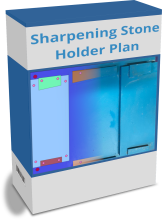Sharpening Stone Holder
Contents
- 00:00 Introduction
- 00:50 Demonstration of the problem
- 01:07 Demonstration of the solution
- 01:36 Exploded view of the sharpening stone holder model
- 05:55 Discussion about available methods of creating symmetrical features
- 07:42 Placing the mounting holes
- 11:44 Creating the remaining holes using the Multitransform tool
- 12:30 Modelling the Shapton Stone base
- 17:00 Assembling the sharpening stone holder
- 19:32 Investigating and repairing a problem in the design
- 21:50 Reasse
I was having difficulty getting the blades of my handtools sharp consistently. My technique was part of the problem, but by far the major part of the problem was my sharpening station, which wasn't very good. I set out to improve my sharpening station, in particular the hand tool portion of it.
The biggest issue was ensuring that the Shapton ceramic stones that I use for sharpening were flat. I was using a flat diamond plate to flatten them, but I had damaged it at some point and it was no longer flattening as well as it used to. To combat this I purchased a Pride Abrasives Waterstone Flattening Stone from Timbecon. This made an immediate improvement but it didn't fit particularly well into my stone holder due to its width. This meant that I had to use it on the bench and it moved around, especially when the suction that occurred when flattening the 8000 grit Shapton stone.
I lived with it for a bit, then decided it was time to do something about it.
The solution
The solution was to design and build a new sharpening stone holder. These are the general requirements:
- Must firmly capture the flattening stone, while allowing it to be easily removed for cleaning;
- Must first capture the sharpening stones, while allowing them to be easily removed for flattening and cleaning;
- Must attach to my sharpening bench so that it does not move around;
- Must allow me to use the sharpening stones while the flattening stone is in place, WITHOUT "flattening" my fingers or knuckles at the same time;
Once the requirements were loosely defined, I decided that I only wanted a single fixture that attached to the bench. This meant that it needed to be wide enough so that the three stones. I decided to place the flattening stone in the centre of the fixture because it meant that it would be more difficult for me to flattening my fingers while using the sharpening stones. Similarly I raised the sharpening stones on platforms to raise their tops above the top of the flattening stone for the same reason.
The next thing to decide was how I was going to fix the stones in place on the fixture so that they would not move around while being used, AND so they could be easily removed for flattening and/or cleaning. The solution was the humble wedge. At one end of each stone is a block glued to the fixture. At the other end are two wedges, one fixed and the other loose, which push against each other to provide clamping pressure. The loose wedge is placed between the fixed wedge and the stone, and then push into place using finger pressure to provide sufficient clamping force. Removing the loose wedge removes the clamping pressure and allows the stone to be removed. I used a hardwood for the wedges and end blocks.
Important
The stones are quite brittle so I only use finger pressure on the wedges to prevent the clamping pressure breaking the stones. I have found that finger pressure provides more than enough force to hold the stone in place.
I made the fixture from MDF because it is readily available and is fairly easy to cut. Unfortunately, MDF does not hold screws very well, nor is the general MDF waterproof or water resistant. I used dowels to attach each part to the fixture because they provide more strength than screws, and because they will not damage the blades if I do something stupid like hitting one with the blade. I spray painted the finished fixture to improve its resistance to water.
My hand tool sharpening kit
This is a list of the tools I have in my hand tool sharpening kit. I have provided a link to where you can buy them in Australia. 1
Note
I hone my blade freehand and don't use a honing guide in my sharpening process. The design of the fixture does not prevent you using one if you want to.
- Pride Abrasives Waterstone Flattening Stone
- 1000 grit Shapton Professional Sharpening Stone
- 8000 grit Shapton Professional Sharpening Stone
- 1 These are NOT affiliate links and I do not get paid for sharing them. I have bought tools from these companies before and have always received good service from them.
